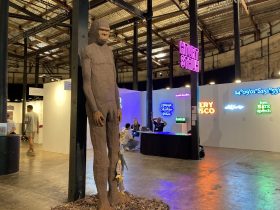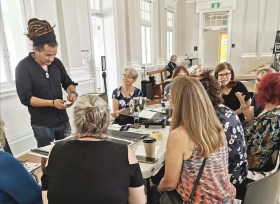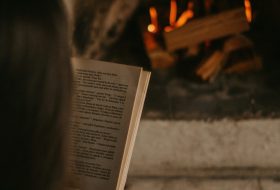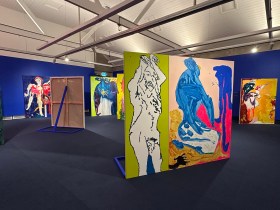Australia has no lack of major sculpture shows, but often they prioritise outdoor works of monumental scale or, conversely, small sculptures that can fit neatly on a shelf.
The new Melbourne Sculpture Biennale – founded by artist Adam Stone and independent curator and arts manager Laura Couttie – has carved out a space for itself, focusing on non-functional sculptures that respond to both the provocation of The Burden of Objects and the heritage Villa Alba Museum.
A look inside Melbourne Sculpture Biennale
The indoor setting opened up material possibilities that would not be viable under different weather conditions, and this is immediately evident in Louise Paramor’s elegant and spirited sculptures with ‘torsos’ made out of archival paper. The five works from the series, High Society (2020), matched the lavishly decorated Drawing Room at first glance, but also played on the juxtaposition with other ‘cheap’ materials like a broom and hula hoop.
Kathy Temin’s Pet Tombs tapped into a similar trope with its fluffy and slightly untamed presence, evoking Dr Seuss’ Lorax, while the title suggested an alternative way to celebrate our dear companions in the afterlife.
The Burden of Objects considered the labour, cost and the logistic barriers that come with a practice in sculpture. Cate Consandine’s Viraginis (2022) encapsulated these elements all in one – a 70-kilogram polished bronze sculpture of the lower extremity of a body with legs outstretched in balanced tension. Suspended on a truss frame, it stole the attention even from far across the ground-level entrance, framed the vestibule doors and the stretch of 12-metre long painted marine scenes as its backdrop.
On the flip side of the coin was Catherine Bell’s Bouquet #5 (Roses for Archie) and pieces from the series, Maker Unknown (2022), each a memorial to overlooked Australian women artists. These were hand-carved from florist foam requiring dexterity and possibly resilience towards failure as even a small mistake could mean a complete restart.
A handful of figurative sculptures showed wide-ranging approaches, from Ronnie van Hout’s hauntingly delightful blue demon that seemly emerged from a bad dream (Trinity, 2024) to Terry William’s stuffed soft sculptures that occupied Room 7 as if in secret assembly.
What captivated me the most though, was the faint echo of upbeat music that came from the room labelled ‘Lavatory’, which housed a Makita 18V Jobsite Radio – a bluetooth radio favoured by construction workers for its ability to cut through noise, tuned to Triple M inside a custom-made perspex cover.
Titled Site Specific (2024) by Dan Moynihan – who has a day-job at Bunnings and also works as a construction worker – the piece brought a nuanced through line to the exhibition. Its double entendre referred to the mode of contemporary art-making tailored for its surroundings and the construction site. The tension between ‘high brow’ and ‘low brow’ was also palpable, placing into stark contrast the well-off family that commissioned the construction and decoration of the mansion and the people who built and refurbished the place – the latter muffled like the sound under the perspex.
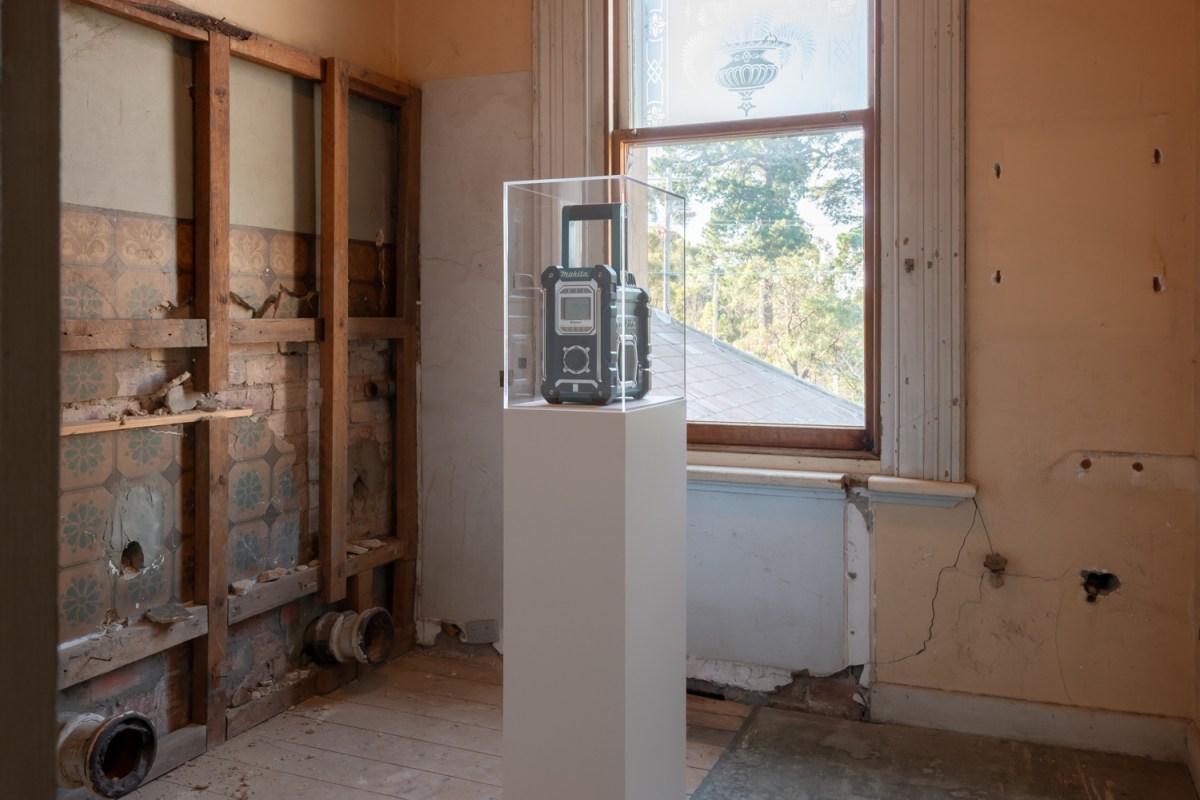
While the first edition of the Melbourne Sculpture Biennale did have an outdoor component, situated around the Villa Alba Gardens that surround the mansion, it was a more diluted presentation that paled against the indoor presentation. For example, Noriko Nakamura’s elaborate, and sometimes suggestive, limestone sculptures did fit comfortably in their outdoor setting, but they were located in a narrow walkway more suited for visitors to pass through rather than linger in.
There were also logistical elements that can be improved in future, such as timed-entry to help with crowd control (though the popularity of the free event is a strong encouragement for the Biennale), a clearer understanding and implementation of guidelines inside a delicately maintained heritage venue, and a small tweak to include artists’ names with the floor plan handout for easy cross-reference.
Read: Exhibition review: Primavera 2024: Young Australian Artists, MCA
Beside these suggestions, the inaugural Melbourne Sculpture Biennale has punched above its weight and the city is lucky to have this new initiative platforming critical investigations into contemporary sculpture.
2024 Melbourne Sculpture Biennale, The Burden of Objects, ran from 9-13 October at Villa Alba Museum.
Missed the show? Check out a video walk-through of the 2024 Melbourne Sculpture Biennale:


